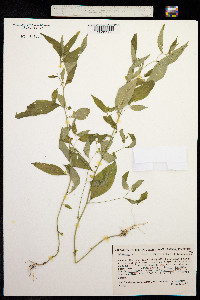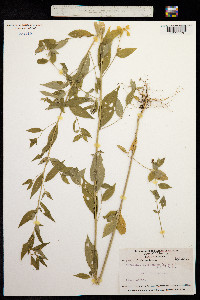Hybanthus attenuatus
|
|
|
|
Family: Violaceae
western greenviolet, more...western green-violet
[Ionidium parietariifolium] |
Plant: annual herb; 11-46 cm tall. STEMS erect, leafy with few branches, glabrous to pilose (especially upper half), often purple-mottled Leaves: stipules 1-5 mm long, to 0.5 mm wide, linear, glabrous; petioles 4-7 mm long; blades 1.5-10.5 cm long, 3-23 mm wide, elliptic to lanceolate, coarsely pubescent to glabrous, the tips and bases attenuate, the margins crenate to usually serrate, ciliate; lower leaves opposite, the upper leaves alternate INFLORESCENCE: flowers (1-)2-4 per leaf axil, often with 1-2 aborting, the pedicels 0.2-2 cm long, pubescent, erect to horizontal Flowers: sepals narrow, long acuminate, entire, ciliate, 2-5 mm long, 0.5 mm wide at the base, the lower petals 7-12 mm long, spatulate, the tip 4-7 mm wide above a median constriction, this 1-2 mm wide, the petal base 2-3 mm wide, glabrous to pubescent on upper surface, petal edges and veins purple veins purple; lateral petals 0.5-2 mm long, thin, white or purple- tinged; upper petals ca. 2 mm long, purple tipped. Cleistogamous flowers present on short pedicels Fruit: FRUITS 3-5.5 mm long, ovoid, usually short-beaked, glabrous; SEEDS ca. 6 per capsule, globose to somewhat flattened with angular edges, dark brown to black with white to gray patches; caruncle white to cream-colored, hood-shaped Misc: Shaded areas in canyons, near water; 1200-1850 m (4000-6000 ft); Aug-Oct REFERENCES: Little, R. John. Violaceae. 2001. J. Ariz. - Nev. Acad. Sci. Volume 33(1). Little 2001, Kearney and Peebles 1969 Duration: Annual Nativity: Native Lifeform: Forb/Herb General: Herbaceous annuals to 46 cm tall; stems erect, leafy, with few branches; surfaces glabrous to pilose, especially on the upper half, often purple-mottled. Leaves: Lower leaves opposite, upper leaves alternate; blades 1-11 cm long, 3-23 mm wide, elliptic to lanceolate or rhombic-lanceolate, surfaces coarsely pubescent to glabrous, tips and bases attenuate, margins crenate to usually serrate and ciliate; stipules 1-5 mm long, to 0.5 mm wide, linear, glabrous; petioles 4-7 mm long. Flowers: Small, white to purple, and zygomorphic, in clusters of 1-4 flowers per leaf axil; often 1-2 flowers in each cluster abort; flowers have 5 petals, including 1 lower (large), 2 lateral and 2 upper; the lower petals 7-12 mm long, spatulate, the tip 4-7 mm wide above a median constriction, this 1-2 mm wide, petal bases 2-3 mm wide, glabrous to pubescent on upper surfaces, edges and veins purple; lateral petals 0.5-2 mm long, thin, white or purple- tinged; upper petals 2 mm long, purple tipped; sepals narrow, long-acuminate, entire, ciliate, 2-5 mm long, 0.5 mm wide at the base; pedicels 0.2-2 cm long, pubescent, erect to horizontal; cleistogamous flowers sometimes present on short pedicels. Fruits: Capsules, ovoid, 3-6 mm long, usually short-beaked, surfaces glabrous. Seeds 6 per capsule, globose to somewhat flattened with angular edges, dark brown to black with white or gray patches; caruncles (appendages on seeds) white to cream-colored, hood-shap Ecology: Found in shaded areas in canyons, near water, from 3,000-6,000 ft (914-1829 m); flowers August-October. Distribution: s. AZ in Pima, Cochise, and Santa Cruz counties, south through MEX and C. Amer. to Colombia, Ecuador, and Peru. Notes: This species is in the violet family, and shares with violets the traits of thriving in moist environments and having zygomorphic flowers (i.e. bilaterally symmetrical). However, Hybanthus flowers differ from the more familiar violets in that the single lower petal is relatively large, showy, and constricted in the middle, while the other 4 petals are reduced to less than half the length of the showy lower petal. The flowers are somewhat difficult to see, as they are surrounded by long, acuminate sepals. There are two species of Hybanthus in Arizona; H. attenuatus is annual, with petiolate leaves and flowers in clusters of 2-4 in the leaf axils; H. verticillatus is a perennial with sessile to subsessile leaves, and flowers solitary in the leaf axils. Ethnobotany: Unknown, but other species in the genus have uses. Etymology: Hybanthus is from Greek hybos for humpbacked and anthos for flower, referring to the genus-s unique floral morphology; attenuatus means narrowed to a point, referencing the leaf shape. Synonyms: Ionidium attenuatum Editor: LCrumbacher 2012, AHazelton 2015 |
|
|
|















































